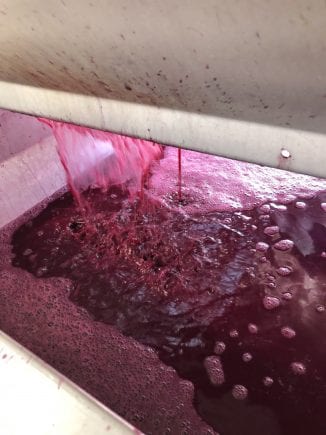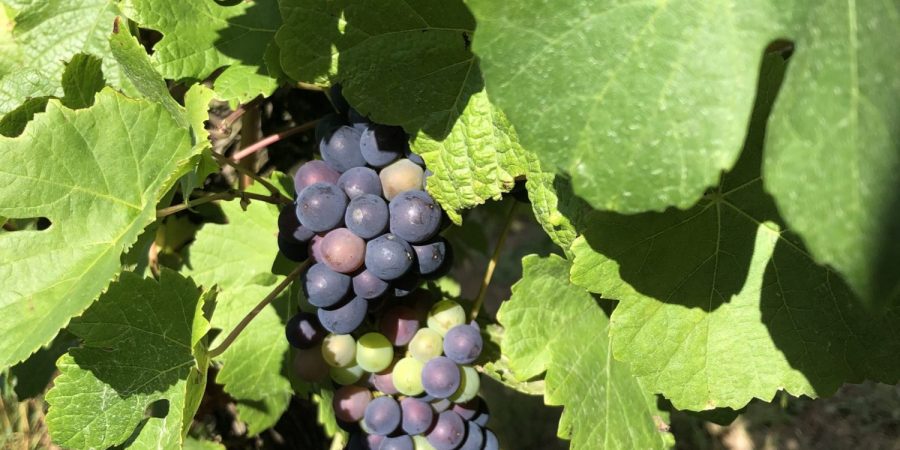Last week, we spoke about assessing sugar levels in grapes as a way of figuring out when they’re ready to pick.
But, that’s only half the story.
This week, let’s take a look at how acidity can also is also used as an indication of grape ripeness.
But just before I forget…
We haven’t started picking any grapes for Vintage 2022 yet… but it’s just a matter of days away!
The acid story
Acids are the components that give wine its fresh, crisp taste. The main acids in grapes are tartaric and malic acid. These acids are found naturally in grapes, but can also be added as an “adjustment” during the winemaking process.
The overall concentration of acid present in the juice is expressed as titratable acidity (g/L TA).
The chemical effectiveness of the acids (or how they influence chemical reactions in the juice) is referred to as pH.
Both tartaric and malic acids are produced in the berry during the early stages of berry growth. They reach their maximum levels about veraison and then decrease in concentration during the ripening period.
With berry ripening titratable acidity decreases and pH increases.
Measurements of pH and TA are taken on the juice of sample berries collected from the vineyard.
It’s the values of these measurements and their balance with the sugar level that helps winemakers to decide when to pick the grapes.
How to measure pH and TA
These measurements can’t be made in the field. You need to bring a sample of grapes back to a lab with specialised equipment.
The pH of grape juice or wine is determined using a pH meter and electrode.
Titratable acidity is measured by titrating a sample of wine or juice against a strong base, 0.1M sodium hydroxide.
I know that is going to make little sense to many of you, so here is an (incredibly boring) video I stole/borrowed from YouTube if you’re interested in exactly how it is done…
If you’re still awake, let’s move on…!
Loving our blog? Sign up for weekly updates straight to your inbox…
Acid in wine
 Just like how measurements of sugar happen right throughout the fermentation process in the winery, winemakers continue to assess the pH and TA levels as the grape juice is turned into wine.
Just like how measurements of sugar happen right throughout the fermentation process in the winery, winemakers continue to assess the pH and TA levels as the grape juice is turned into wine.
As mentioned previously, tartatric and malic acid are present in grapes and are carried over into the wine. Other acids may be formed by yeast and bacteria during winemaking. They include lactic acid, acetic acid and succinic acid.
Titratable acidity is the measure of all forms of all the acids and gives an estimate of their overall concentration. Values for TA in wine may be in the order of 6 to 10 grams of acid per litre. The concentration of acid relates to the acid taste of wine. Generally, the higher the TA, the more acidic the wine will taste.
The concept of pH is a trickier one. It measures the concentration of only free hydrogen ions. But these are really important because they influence chemical reactions in the juice and wine. The thing is, they occur in tiny concentrations (0.001 to 0.0001 g/L) so scientists have come up with a more convenient scale.
The pH scale ranges from 0 to 14. Values from 0 to 7 represent acidic solutions and from 7 to 14 are basic solutions. pH 7 is neutral (water is usually around pH 7). The lower the number of the pH scale, the more acidic the solution.
And here’s the thing that’s important when it comes to wine…
The lower the pH value of a juice or wine, the less chance of oxidations and spoilage reactions occurring. Also, if the pH of a red wine is adjusted to a lower value the wine will appear redder.
The pH value of grape juice and wine is normally in the range of pH 3 to 4. Even though this seems like a small range, the differences in the chemical reactions and wine colour that can occur can be quite dramatic. And don’t forget, juices or wines at the higher end of the scale can oxidise very quickly.
For this reason, winemakers will adjust the pH to a lower value by adding tartaric acid. They must do this carefully though and taste the wine after each addition. There is a risk that adding too much will throw out the balance of the wine.
During the winemaking process, the pH naturally increases. Winemakers need to check the pH regularly and adjust if necessary. The aim is to achieve an acid level that is in balance with the sugar, alcohol and fruit in the wine.
A nice analogy
(thanks to Australian Wine: from vine to glass by Patrick Illand and Peter Gago)…
If this is all seems way too complicated, think of it as a bank account:
Titratable acidity gives a measure of the total amount of money in the account (capital + interest).
pH gives a measure of the interest, and thus how effectively the account is operating.
Simple!!
